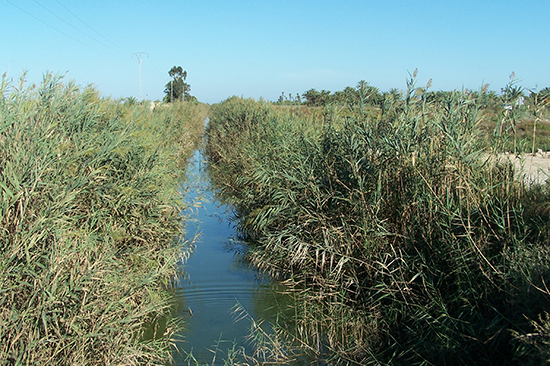
 © Carlos Martín |
«The phenomenon at the Reeds is an evidence of the practicality of disciplines like ethnobotany. They are useful tools for society, and can lead to direct action on the land» |
|
|
For some time now, a group of irrigators from the south of the province of Alicante have been mobilising in order to achieve a better environmental protection of the lands they work, near to the natural park of El Hondo. However, it was not always like this, as Carlos Martín points out, member of the Multidisciplinary Institute for Environmental Studies «Ramon Margalef», from the University of Alicante: «A few years ago, the organisation and mobilisation of this group of people would have been unthinkable, since until very recently there was an open conflict between the administration and the irrigators, due to the environmental restrictions that the government imposed and the claims of the labourers for applying concrete to the irrigation channels, because the pruning of the reeds every now and then was a lot of work». But the attitude of the irrigators radically changed, in part, thanks to the intervention of the promotion team of the WADI project, a project launched by the UE in 2006 for the study of the ecological, cultural, and socioeconomic aspects of the different Mediterranean and North- African water systems. This project sent Carlos Martín to Elx, where he analysed the Reeds area, formed by an old marsh and a salt marsh, deteriorated as a consequence of the neglect of the area and the few future perspectives of the agrarian activity, which risked the survival of this natural space. The WADI programme, developed between 2006 and 2008, brought about the agreement between irrigators and the administration, which understood that without the support of the land labourers, the maintenance of the area was unfeasible. The research of the European project was the first one of a great deal of ecologic initiatives that have been carried out in this area in the last few years. The main difference is that, while the WADI project was promoted and executed by “alien” people to the salt marsh —professionals from the University of Alicante—, the last actions have been carried out by the people of the region. According to Carlos Martín, the phenomenon at the Reeds is an evidence of the practicality of disciplines like ethnobotany (the science that studies the relationship of the people and the plants in their environment). They are useful tools for society, and can lead to direct action on the land. «With the WADI project we thought that ethnobotany could play a real role in the promotion of sustainability of natural systems», explains Martín, who, six years later, is satisfied with the work done. The ethnobotanic studies carried out in the Reeds have been useful to “visualise” the reality of the area and «to emphasise the value of the agrarian knowledge which was running the risk of being forgotten». |
||
 © Carlos Martín |
«Up to this moment, the irrigators have achieved many things, they have asked of the Generalitat Valenciana (local government) to declare the Reeds an Special Area for the Protection of Birds» |
|
|
An ecological corridor with more than 170 bird species The irrigators from the South of Elx started to grasp the importance of the area they used for farming and also the great interest it meant for them, and for the inhabitants of the area, the promotion of activities that guaranteed the sustainability of the park since these studies were carried out by the European programme. «Usually, the land labourer tends to despise any plant that does not give a fruit» Carlos Martín explained, «that is why their interest in the reeds was inexistent». In a few months, this changed and today the community of irrigators of the Reeds works actively together with other local organisations in order to have the area officially declared an Agricultural Natural Park. However, this denomination seems hard to achieve nowadays, since this title does not exist in any agrarian or environmental regulation. All in all, the community has the support of all the organisations involved, and has contacted the irrigators of the Agricultural Natural Park of Baix Llobregat, an agricultural periurban area near to Barcelona. Moreover, the recuperation action of the park has not been reduced to only administrative claims, but it was the irrigators themselves who designed reaping machines that respect the environment, and who commissioned the biologist from the University of Alicante, Antonio Belda, to make an ethnobotanic list of the flora of the park, a tool that has proved to be useful for the recuperation of activities that were being abandoned, like the use of vegetables for obtaining soda. Up to this moment, the irrigators have achieved many things. The irrigators have asked of the Generalitat Valenciana (local government) to declare the Reeds a Special Area for the Protection of Birds, with the ends of maintaining biodiversity in this natural spot, an «ecological corridor» placed between the El Hondo Natural Park and the Santa Pola saltmarshes. More than 170 species of birds live in the park, like the marbled duck (Marmaronetta angustirostris), the pratincole (Glareola pratincola) or the common crane (Grus grus), as well as other sub-aquatic species like the mullet (Mugil), or mammals like hedgehogs (Erinaceus) or hares (Lepus sp.). Among the salt marshes, the farm lands, the Arab irrigation channels and the lagoons we can find species like marsh-rosemary (Limonium), rushes (Juncus sp.), salt tolerant coastal plants (Sarcocornia), or the common chicory (Cichorium). And, of course, reeds (Phragmites australis). Reeds, that species formerly despised which, after all, has ended up being the excuse for a forlorn area to be recuperated, harbouring thousands of species whose survival was becoming increasingly vulnerable, due to the growth model society is determined to carry out turning its back to nature. José Vicente Bernabeu. Student of Journalism at the University of Valencia. |





